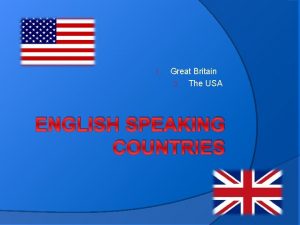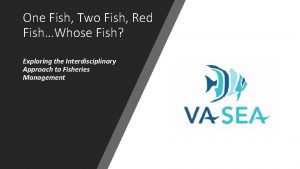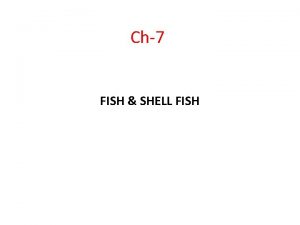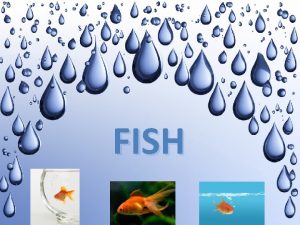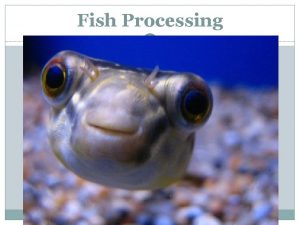Fish What is a fish Fish consist of




















- Slides: 20

Fish!

What is a fish? • Fish consist of all gill-bearing aquatic craniate (with a spine and head) animals • They lack limbs with digits (finger or toes). • At 32, 000 species, fish exhibit greater species diversity than any other group of vertebrates.

Body Temperature • Most fish are ectothermic ("cold-blooded"), allowing their body temperatures to vary as temperatures around them change. • Some of the large active swimmers like white sharks and tuna can hold a higher core temperature because of their size.


Body Temperature • Some larger fish, such as tuna have such advanced blood heating systems, they can actually cook their flesh! • When tuna fishermen catch a fish, they must let it swim behind the boat until it gets into shore or the tuna will struggle so much it will cook the flesh along it’s backbone.


Breathing • A gill is a respiratory organ that extracts dissolved oxygen from water, and excretes carbon dioxide. • A gill surface must be kept moist in order for gas exchange to take place. • Some aquatic species that can transition from land to water (such as hermit crabs) can breathe on both land in water as long as the gills are kept moist.

• The more active an aquatic species is, the more need for gills arise. Some species can breathe by absorbing oxygen through the entire surface of their bodies.

• Gills usually consist of thin filaments of tissue or branches that are highly folded to increase surface area. • A high surface area is crucial to the gas exchange of aquatic organisms as water contains only a small fraction of the dissolved oxygen that air does.

• The folds contain blood, from which gases are exchanged through the thin walls. • The blood carries oxygen to other parts of the body. • Carbon dioxide passes from the blood through the thin gill tissue into the water.


Environments • Fish are abundant in most bodies of water. They can be found in nearly all aquatic environments, from high mountain streams (e. g. , char and gudgeon) to deepest oceans (e. g. , gulpers and anglerfish).

Char Fish Gudgeon Gulper Eel Angler Fish

Hagfish • Hagfish are eel-shaped slime-producing marine animals (occasionally called slime eels). • They are the only living animals that have a skull but not a vertebral column (spine). • Along with lampreys, hagfish are jawless and are living fossils.

Lampreys • Lampreys (sometimes also called lamprey eels) are jawless fish and are characterized by a toothed, funnel-like sucking mouth. • While lampreys are well-known for those species which bore into the flesh of other fish to suck their blood, most species of lamprey are not parasitic and never feed on other fish.

Cartilaginous • Cartilaginous fishes are jawed fish with paired fins, scales, a two-chambered heart, and skeletons made of cartilage rather than bone. • Lack ribs, so if they leave water, the larger species' own body weight would crush their internal organs long before they suffocate. • Includes sharks, ray fish and skate fish.

Bony Fish • Group of fish that have bones, as opposed to cartilaginous, skeletons. • It is the largest class of vertebrates in existence today. • They are divided into ray-finned fish and lobe-finned fish.

Fin Types Ray Finned Fish Lobe Finned Fish

Manitoba Fish – Walleye/Pickrel • Walleye is a freshwater fish native to most of Canada and to the northern United States. • In some parts of its range, the walleye is known as the colored pike, yellow pike or pickerel (esp. in English-speaking Canada). • Has been genetically bred with many other fish to make sub-species.

 One fish two fish red fish blue fish ride
One fish two fish red fish blue fish ride One fish two fish blowfish blue fish
One fish two fish blowfish blue fish Characteristics of actinopterygii
Characteristics of actinopterygii What does britain consist of
What does britain consist of What do taoist believe
What do taoist believe Product costs consist of
Product costs consist of What is blood composed of
What is blood composed of Consist of many overlapping food chains
Consist of many overlapping food chains What does an ict system consist of
What does an ict system consist of Which cookie is valid for single session only
Which cookie is valid for single session only What does the united kingdom consist of
What does the united kingdom consist of Reseller markets consist mainly of
Reseller markets consist mainly of Law of gearing
Law of gearing Multiwire branch circuit
Multiwire branch circuit Worksheet formulas consist of two components: operands and
Worksheet formulas consist of two components: operands and Choosing brand elements
Choosing brand elements Ipo chart java
Ipo chart java Safety net drop tests must consist of a
Safety net drop tests must consist of a Consist of your most important targeted or segmented groups
Consist of your most important targeted or segmented groups Dipthongs
Dipthongs Great britain consist of
Great britain consist of




















